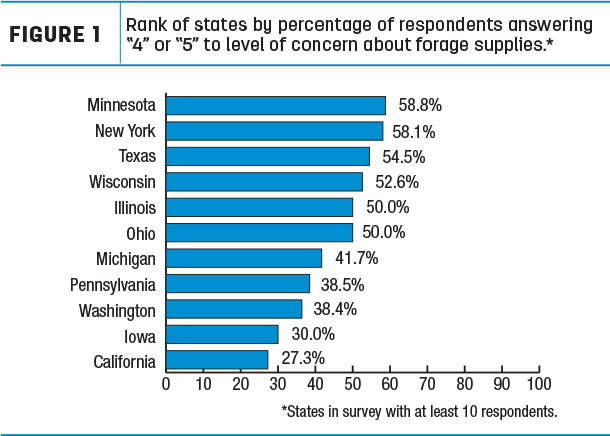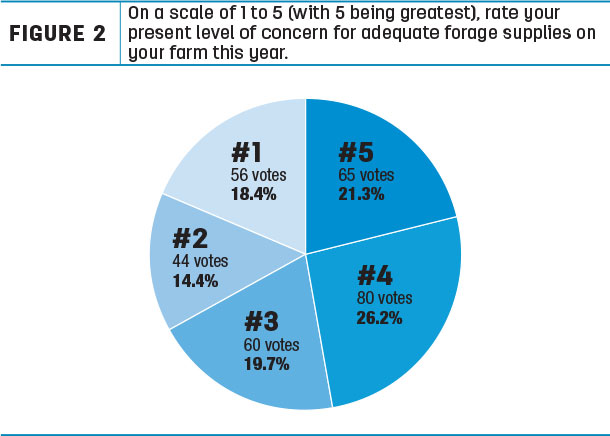Beginning this summer, we asked readers: “On a scale of 1 to 5 (with 5 being greatest), rate your present level of concern for adequate forage supplies on your farm this year?” More than 400 responses were collected online and over the phone from July through August 2019. Readers indicating a level of concern of “4” or “5” made up 47.5% of the votes.

Concerns about forage production began early this year after wet springs in the Midwest, upper Northeast and Pacific Northwest delayed first-crop forage cuttings and plantings of corn silage. Evidence of this concern was evident in the poll. Readers in Wisconsin, Minnesota and New York were among the states with the highest percentage of those polled on high alert.

Combined with severe alfalfa winterkill in parts of the Midwest, terms like “scarce” and “disaster” were being used to describe forage conditions and compelling leaders of agricultural organizations to seek flexibility in USDA crop programs to address current and impending forage shortages. That was compounded by the fact hay inventories stored on farms as of May 1 were the lowest total that date since 2013. All those forces helped push May 2019 U.S. average hay prices to their highest level in five years.
One promising sign for forage production comes from a look at the USDA’s weekly drought monitor maps. Although some hay-producing areas of the country are showing normal summer drought patterns, alfalfa- and other hay-producing areas considered under drought conditions as of mid-August (just 2% and 4%, respectively) are the smallest in a decade. Dry pockets are in the Pacific Northwest, along the Oklahoma/Texas border, North Dakota and scattered in some areas of the Southeast and Illinois and Iowa.
As a result, the USDA’s August Crop Production report forecasts higher yields, with record-high alfalfa hay yields expected in Arizona, California, New Mexico and Oregon. Nationally, yields of other hay are also expected to be a record high.
Even though moisture conditions have improved the outlook for forage supplies, production figures don’t tell the whole story. More moisture has raised questions regarding quality.
“While we maybe have a few more tons of hay per acre or part of a ton per acre, maybe that quality isn’t in that dairy-quality or that high-end prime-type alfalfa grade that we would like to get,” said Richard Halopka, University of Wisconsin Extension crops agent, writing in a mid-August report on conditions in the Upper Midwest. And, Halopka says, he still hears from farmers concerned about not having enough feed this winter.
Latest regional reports express quality concerns outside the Midwest, too. In Texas, quality issues remain a concern due to extreme early season rainfall followed by extreme heat. Nebraska producers continued to struggle with getting top-quality hay due to heavy dews, low winds and cloudy days. Alfalfa testing over 185 relative feed value (RFV) was hard to find in Idaho. Some Montana producers had hay down for 10 to 15 days or more before finally getting it baled and were forced to sell at bedding prices. Other producers opted to rerun it through the swather and bale it with second cutting.
So far this year, samples of haylage submitted to Rock River Laboratory have seen a significant decrease in crude protein (CP). The haylages from the West have held steady in their CP averages, while haylages from the East have dipped slightly. Haylages from the Midwest have seen the greatest declines in CP. ![]()
For regular updates on forage markets and conditions, visit the Progressive Forage Hay Market Reports website: Progressive Forage: Hay market reports.







